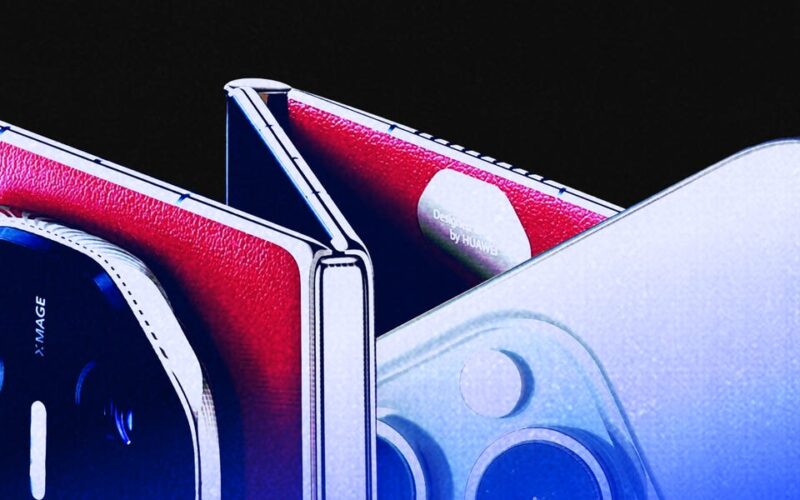Huawei’s trifold smartphone, the Mate XT, debuted Friday in China, as did Apple’s iPhone 16 — and it’s turning out to be a showdown between the tech rivals in the largest smartphone market in the world, where Apple is working to reclaim slipping territory.
The competition has been tight over the past year, and Huawei has looked to upstage Apple with its most recent launch.
Hours after Apple unveiled its iPhone 16 models earlier this month, Huawei announced the Mate XT would drop on the same day.
Huawei said it secured over 2.7 million preorders for the trifold smartphone in the first few hours, and the $2,800 device was listed at three times its retail price on resale sites. Ahead of launch day, the company said preorders crossed 6.5 million units.
For Americans, there won’t be the temptation to choose the Mate XT over the iPhone 16, as the Chinese smartphones haven’t been available directly from the company in the US since being placed on the “Entity List” in 2019.
But in China, Huawei started delivering its new phones to customers who preordered them shortly after 10 a.m. local time on Friday, CNBC reported from Beijing. While people lined up at Apple stores as early as 5:30 a.m. to be first in line for the new iPhone when stores opened at 8 a.m., Huawei stores in Beijing and Hefei didn’t have lines, the news outlet reported.
Reuters reported seeing about 30 people lining up at the Huawei stores in Shenzhen and Beijing, compared with Apple’s 100 prospective customers lined up outside a Beijing store.
The disparity could be partly due to how Huawei distributed the first batch of Mate XT sales. Some superfans of the company told Reuters they were disappointed to find out that they couldn’t walk in to purchase the trifold device, which was apparently reserved for people who had preordered it.
Huawei did not immediately respond to a request for comment made outside local business hours.
Key differences in price — and design
To make the competition between the companies even more intense, both brands are touting their own artificial-intelligence features.
The Mate XT includes generative-AI and satellite-communication features. Meanwhile, Apple has made splashy announcements of its own gen-AI offerings, collectively called Apple Intelligence, but those features won’t start rolling out to the iPhone 16 until October.
The phones are otherwise strikingly different in appearance and price, with Huawei benefiting on social media from its eye-catching trifold design, which allows the phone to expand out into a tablet-sized device with a 10.2-inch screen.
CFOTO/Future Publishing via Getty Images
It’s one step further than previous foldable-phone designs, and the Mate XT’s $2,800 price tag means customers will have to pay a hefty premium to be among the first to own the phone. Apple’s iPhone 16 line starts at $800.
Apple’s hardware design is more iterative by comparison, but there are some notable changes. The iPhone 16 offers a new “camera control” button and brings the “action” button previously found only on the iPhone 15 Pro models to the entry-level iPhone 16 as well.
Apple
While Apple is betting that subtler tweaks to its form factor and bigger changes to its software will persuade buyers to upgrade to the iPhone 16 line, there are signs we could see some different designs in the coming years.
Apple, The Information reported in February, has been exploring prototypes for two folding phones after chewing on the idea for years. The tech giant, which typically prefers to wait to launch into a new category until it feels ready to dominate it, would be late to the game as competitors have already produced similar products, including US-available Samsung and Google Pixel devices.
In the meantime, the company is looking to launch a noticeably thinner iPhone Air as soon as next year, Bloomberg reported last month.
Apple has faced headwinds in China
In 2023, Apple became the best-selling smartphone in China, a monumental achievement that came years after the US slapped sanctions on Huawei in 2019, which locked the Chinese company out of access to the newest semiconductors. In response, Huawei designed its own processors to use in a line of smartphones released in April.
But Apple’s victory was short-lived as the company’s iPhone sales in China fell an estimated 24% in the first six weeks of 2024, according to data from the market-research firm Counterpoint Research. Vivo became the new top smartphone seller in the region.
Since then, Apple has faced questions from Wall Street during its earnings calls about the company’s smartphone sales in China.
Vivo maintained its lead in China in the second quarter, followed by Apple and Huawei, Counterpoint Research found. Apple saw an estimated 5.7% market-share decline year over year in the quarter, while Huawei’s sales jumped nearly 45% over the same period, the firm’s data showed.
Some on Wall Street, such as the analyst firm Wedbush Securities, feel that Apple could be turning a corner in China with the iPhone 16.
The firm predicted earlier this month that the iPhone 16 will be Apple’s “most successful iPhone unit launch in its history as Apple Intelligence will be the launching pad for the consumer AI Revolution globally.”
But with fierce launch-day competition in China, you can bet Wall Street will be looking to see whether Huawei complicates the Apple comeback story.
Source link
lol

